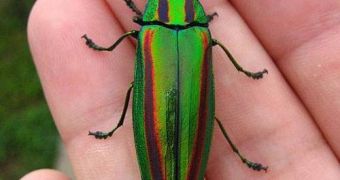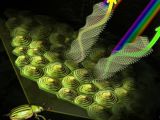Experts at the Georgia Institute of Technology (Georgia Tech) became fascinated with the shimmering lights that were reflected off the jewel beetle (Buprestidae family) some time ago, and decided that the amazing trait merited further investigation. The iridescent glow that these insects give off points at the fact that they reflect light in a very peculiar fashion, and the Georgia Tech team believes that researching this aspect could result in a new way of looking at colors. New classes of materials could be devised that will not generate colors by absorbing parts of the visible light's wavelengths, but by reflecting them.
“The Chrysina gloriosa beetle reflects a green light. This has been known for about 100 years, but we've determined the colors we see result from the beetle's physical structure rather than its biology,” lead study researcher Mohan Srinivasarao explains the interest researchers have in the insect. He holds an appointment in the School of Polymer, Textile & Fiber Engineering at the Institute. Details of the team's investigations appear in the July 24th issue of the respected journal Science.
Regularly, when light strikes a surface that is hard to see through, it is either reflected, absorbed or scattered. These modifications of its wavelength structure are the main factors that generate colors. But the beetle's outer shell does not generate them in this matter. Rather, when light hits it, it rearranges multi-faceted cells on its back, which in turn reflect light, producing colors. These specialized cells have either five, six or seven faces.
Most often, they produce red, green and yellow, but the team infers that other kinds of cells could, at least in theory, emit all the colors imaginable. Srinivasarao compares these photo-reflective cells to “cholesteric” liquid crystals, which are part of a class of liquid crystals exhibiting cone-like structures on their surface, as well as a helical arrangement of molecules. The pitch in these helices are the main factor that determines how incoming wavelengths are scattered, and what metallic colors are produced.
The expert believes that much more research is needed, if scientists are to understand precisely how light is reflected. There are still numerous factors that are unknown, without which practical applications of the discovery cannot be devised. “It's stunning how similar the two things are,” Srinivasarao says of the beetle shell cells and the liquid crystal class. The research was supported with funds from the US National Science Foundation (NSF).

 14 DAY TRIAL //
14 DAY TRIAL // 
